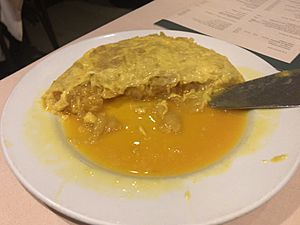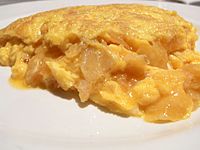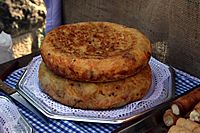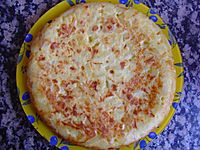Spanish omelette facts for kids
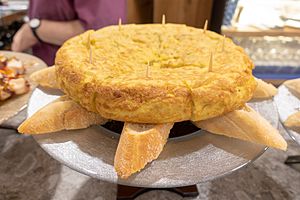
Spanish omelette in a pinchos bar in San Sebastián
|
|
| Alternative names | Tortilla de patatas Tortilla de papas Tortilla española Spanish tortilla Potato omelete |
|---|---|
| Course | Tapas, appetizer or main course |
| Place of origin | Spain |
| Serving temperature | Either warm or room temperature |
| Main ingredients | Egg and potatoes |
| Variations | May include onion |
The Spanish omelette is a super famous dish from Spain. People in Spain love it so much, it's like their national food! It's a type of omelette made with eggs and potatoes. Sometimes, it also has onions. You can eat it warm or at room temperature. It's often served as a tapa, which are small snacks.
In Spanish-speaking countries, it's usually called tortilla de patatas, tortilla de papas, or tortilla española.
Contents
The History of Spanish Omelette
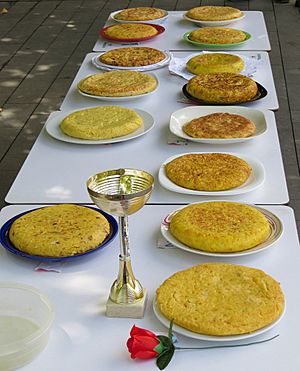
The first time anyone wrote about the Spanish omelette was in a document from Navarre, Spain, way back in 1817. This old paper talked about how farmers in Navarre didn't have much food. It said they would make a "big and thick" omelette with just "two to three eggs" for "5 or 6 people." They would mix in potatoes, breadcrumbs, or whatever else they had!
There's a cool story about how the omelette might have been invented. During a war in 1835, a general named Tomás de Zumalacárregui was trying to feed his army. Legend says he created the tortilla de patatas because it was easy, fast, and filling. It helped feed his soldiers when food was scarce. Even if this story isn't totally true, the omelette did become popular around that time.
Another tale says Spanish prisoners learned the recipe in 1665. They were captured after a battle and held for three years in Portugal. When they finally went home, they brought back many new ideas, including a potato and egg pie. This pie might have slowly turned into the Spanish omelette we know today!
What's in a Name?
The word tortilla in Spain means 'omelette'. So, a potato omelette is called a tortilla de patatas (potato omelette) or papas (another word for potatoes).
This dish has become famous all over the world! To avoid confusion with the thin, flatbread tortilla from Mexico and Central America, people started calling it tortilla española or 'Spanish tortilla'. So, in English, you'll hear 'Spanish omelette' or 'Spanish tortilla'. In Spain, if you just say tortilla, everyone knows you mean the potato one. If you want a plain omelette (just eggs), you ask for a tortilla francesa, which means 'French omelette'!
The word tortilla actually comes from torta, which means 'small pancake'.
How to Enjoy and Make a Spanish Omelette
The Spanish omelette is one of the most common dishes you'll find in Spain. People in some Spanish-speaking countries also love to make it.
One big question about Spanish omelette is: should it have onions or not? People usually have a strong opinion! Those who love onion in it are called concebollistas. Those who think onion ruins the dish are called sincebollistas. Restaurants and food companies often tell you if their omelette has onion so you can pick your favorite!
Here's how a Spanish omelette is usually made:
- First, potatoes are cut into thin slices or small cubes. Starchy potatoes work best.
- Then, they are seasoned with salt and cooked slowly in vegetable oil, usually olive oil. If you like onion, sliced onions are added at this stage too. The potatoes and onions are cooked until they are soft, but not brown.
- Next, the cooked potatoes (and onions) are taken out of the pan and drained. They are then mixed with whisked eggs.
- This mixture goes back into the pan and cooks slowly. The cook flips the omelette to cook both sides evenly.
- To flip it, a plate is placed over the pan. The pan is then turned upside down onto the plate.
- Finally, the omelette slides back into the pan to cook the other side until it's just right.
You can eat Spanish omelette hot, at room temperature, or even cold. It's often served as a tapa. Sometimes, it's cut into small, bite-sized pieces with toothpicks. A bigger slice, called a pincho de tortilla, is perfect for eating with your fingers!
-
This is an Asturian tortiella de pataques, known for being quite thick.
Celebrate Tortilla Day!
Día de la Tortilla (which means "Tortilla Day") is a fun celebration in many towns in southern and western Spain. The date changes each year, but it often happens on the first day of Carnival, called Fat Thursday. In eastern Spain, they have a similar party, but they call it jueves Lardero or other names.
On Tortilla Day, people traditionally go to a countryside area near their town. They spend the day with family and friends, eating Spanish tortilla and other yummy foods, and playing games. It's a great way to enjoy the outdoors and good food!
See also
 In Spanish: Tortilla de patatas para niños
In Spanish: Tortilla de patatas para niños


